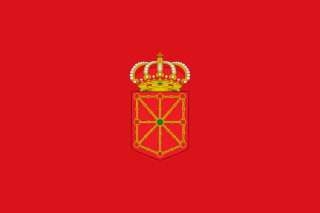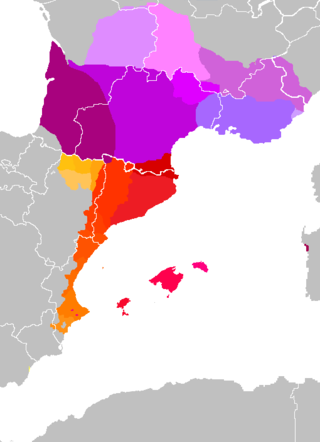
Basque is a language spoken by Basques and other residents of the Basque Country, a region that straddles the westernmost Pyrenees in adjacent parts of northern Spain and southwestern France. Basque is classified as a language isolate and the only language isolate in Europe. The Basques are indigenous to and primarily inhabit the Basque Country. The Basque language is spoken by 806,000 Basques in all territories. Of these, 93.7% (756,000) are in the Spanish area of the Basque Country and the remaining 6.3% (50,000) are in the French portion.

Navarre, officially the Chartered Community of Navarre, is a landlocked foral autonomous community and province in northern Spain, bordering the Basque Autonomous Community, La Rioja, and Aragon in Spain and New Aquitaine in France. The capital city is Pamplona. The present-day province makes up the majority of the territory of the medieval Kingdom of Navarre, a long-standing Pyrenean kingdom that occupied lands on both sides of the western Pyrenees, with its northernmost part, Lower Navarre, located in the southwest corner of France.

Pamplona, historically also known as Pampeluna in English, is the capital city of the Chartered Community of Navarre, in Spain.
The Iberian Romance, Ibero-Romance or sometimes Iberian languages are a group of Romance languages that developed on the Iberian Peninsula, an area consisting primarily of Spain, Portugal, Gibraltar, Andorra and French Catalonia. They are today more commonly separated into West Iberian, East Iberian (Catalan/Valencian) and Mozarabic language groups. East Iberian's classification is a subject of ongoing scholarly debate, as some argue that the Occitano-Romance languages composed of Occitan along with the aforementioned two are better classified as Gallo-Romance languages.

Lower Navarre is a traditional region of the present-day French département of Pyrénées-Atlantiques. It corresponds to the northernmost region of the Kingdom of Navarre during the Middle Ages. After the Spanish conquest of Iberian Navarre (1512–24), this merindad was restored to the rule of the native king, Henry II. Its capitals were Saint-Jean-Pied-de-Port and Saint-Palais. In the extreme north there was the little sovereign Principality of Bidache, with an area of 1,284 km2 (496 sq mi) and a decreasing population of 44,450, 25,356.

The Kingdom of Navarre, originally the Kingdom of Pamplona occupied lands on both sides of the western Pyrenees, with its northernmost areas originally reaching the Atlantic Ocean, between present-day Spain and France.

Fuero, Fur, Foro or Foru is a Spanish legal term and concept. The word comes from Latin forum, an open space used as a market, tribunal and meeting place. The same Latin root is the origin of the French terms for and foire, and the Portuguese terms foro and foral; all of these words have related, but somewhat different meanings.

Lucena is a municipality of Spain belonging to the province of Córdoba, in the autonomous community of Andalusia.

The Continental Celtic languages are the now-extinct group of the Celtic languages that were spoken on the continent of Europe and in central Anatolia, as distinguished from the Insular Celtic languages of the British Isles and Brittany. Continental Celtic is a geographic, rather than linguistic, grouping of the ancient Celtic languages.

Leonese is a set of vernacular Romance language varieties currently spoken in northern and western portions of the historical region of León in Spain, the village of Riudenore and Guadramil in Portugal, sometimes considered another language. In the past, it was spoken in a wider area, including most of the historical region of Leon. The current number of Leonese speakers is estimated at 20,000 to 50,000. Spanish is now the predominant language in the area.

Almodóvar del Campo is a municipality of Spain, located in the province of Ciudad Real, autonomous community of Castilla–La Mancha. Featuring a total area of 1.208,25 km2, it is the largest municipality in the region and one of the largest municipalities in Spain. As of 1 January 2020, it had a population of 5,983.

Asturian is a West Iberian Romance language spoken in the Principality of Asturias, Spain. Asturian is part of a wider linguistic group, the Asturleonese languages. The number of speakers is estimated at 100,000 (native) and 450,000. The dialects of the Astur-Leonese language family are traditionally classified in three groups: Western, Central, and Eastern. For historical and demographic reasons, the standard is based on Central Asturian. Asturian has a distinct grammar, dictionary, and orthography. It is regulated by the Academy of the Asturian Language. Although it is not an official language of Spain, it is protected under the Statute of Autonomy of Asturias and is an elective language in schools. For much of its history, the language has been ignored or "subjected to repeated challenges to its status as a language variety" due to its lack of official status.

Spanish is the language that is predominantly understood and spoken as a first or second language by nearly all of the population of Argentina. According to the latest estimations, the population is currently greater than 45 million.

Occitano-Romance is a branch of the Romance language group that encompasses the Catalan/Valencian, Occitan languages and sometimes Aragonese, spoken in parts of southern France and northeastern Spain.

Basque dialects are linguistic varieties of the Basque language which differ in pronunciation, vocabulary and grammar from each other and from Standard Basque. Between six and nine Basque dialects have been historically distinguished:

Navarro-Aragonese was a Romance language once spoken in a large part of the Ebro River basin, south of the middle Pyrenees; the dialects of the modern Aragonese language, spoken in a small portion of that territory, and the Navarrese dialect can be seen as its last remaining forms. The areas where Navarro-Aragonese was spoken might have included most of Aragon, southern Navarre, and La Rioja. It was also spoken across several towns of central Navarre in a multilingual environment with Occitan, where Basque was the native language.
Bermudo Núñez was a magnate from León and the first Count of Cea. He appears for the first time in 921 confirming a donation to the Monastery of San Benito in Sahagún from which it can be assumed that he was probably born near the end of the 9th century. A loyal vassal of the Leonese monarchs, he confirmed several royal charters and appears with the title of Count from at least the year 950, governing as a tenente the Cea region from 939 onwards.

The Instituto de Enseñanza Secundaria San Isidro is a co-educational day school for pupils from 12 to 18 years of age. It is located in the historical Calle de Toledo in Madrid, Spain.
Saharan Spanish is the variety of the Spanish language spoken in Western Sahara and adjacent regions. This variety is heavily influenced by both Spanish cultural links and a strong expatriate community who live in Spain and Hispanic America, particularly Cuba.
Navarrese is an Ibero-Romance dialect which is spoken in a transitional area between Castilian and Aragonese. Navarrese was originally referred as its own language, however, the obscure dialect was merged into Castilian at the beginning of the 16th century.















